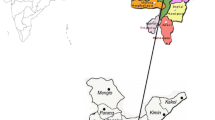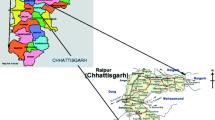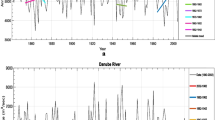Abstract
The perception that hydrometeorological processes are non stationary on timescales that are applicable to extreme value analysis is recently well documented due to natural climate variability or human intervention. In this study the generalized extreme value (GEV) distribution is used to assess nonstationarity in annual maximum daily rainfall time series for selected meteorological stations in Greece and Cyprus. The GEV distribution parameters are specified as functions of time-varying covariates and estimated using the conditional density network (CDN) as proposed by Cannon (2010). The CDN is a probabilistic extension of the multilayer perceptron neural network. If one of the covariates is dependent on time, then the GEV-CDN model could perform non stationary extreme value analysis. Model parameters are estimated via the generalized maximum likelihood (GML) approach using the quasi-Newton BFGS optimization algorithm, and the appropriate GEV-CDN model architecture for a selected meteorological station is selected by fitting increasingly complicated models and choosing the one that minimizes the Akaike information criterion with small sample size correction or the Bayesian information criterion. For each meteorological station in Greece and Cyprus different formulations are tested with combinational cases of stationary and non stationary parameters of the GEV distribution, linear and nonlinear architecture of the CDN and combinations of the input climatic covariates. Climatic covariates examined in this study are the Southern Oscillation Index (SOI), which describes atmospheric circulation in the eastern tropical Pacific related to El Niño Southern Oscillation (ENSO), the Pacific Decadal Oscillation (PDO) index that varies on an interdecadal rather than inter annual time scale and atmospheric circulation patterns as expressed by the Mediterranean Oscillation Index (MOI) and North Atlantic Oscillation (NAO) indices.









Similar content being viewed by others
References
AghaKouchak A, Nasrollahi N (2010) Semi-parametric and parametric inference of extreme value models for rainfall data. Water Resour Manag 24:1229–1249
AghaKouchak A, Easterling D, Hsu K, Schubert S, Sorooshian S, (eds) (2013) Extremes in a changing climate: detection, analysis and uncertainty. Water Science and Technology Library, Vol. 65, Springer, Netherlands.
Aissaoui-Fqayeh I, El Adlouni S, Ouarda TBMJ, St-Hilaire A (2009) Non-stationary lognormal model development and comparison with the non-stationary GEV model. Hydrol Sci J 54:1141–1156
Bishop CM (2006) Pattern recognition and machine learning. Springer-Verlag, New York
Breiman L (1996) Bagging predictors. Mach Learn 24:123–140
Cannon AJ (2010) A flexible nonlinear modelling framework for nonstationary generalized extreme value analysis in hydroclimatology. Hydrol Process 24:673–685
Cannon AJ (2011) GEVcdn: an R package for nonstationary extreme value analysis by generalized extreme value conditional density estimation network. Comput Geosci 37:1532–1533
Cawley GC, Janacek GJ, Haylock MR, Dorling SR (2007) Predictive uncertainty in environmental modelling. Neural Netw 20:537–549
Chu P-S, Zhao X (2011) Bayesian analysis for extreme climatic events: a review. Atmos Res 102(3):243–262
Coles S (2001) An introduction to statistical modelling of extreme values. Springer, London
Coles SG, Dixon MJ (1999) Likelihood-based inference for extreme value models. Extremes 2:5–23
Cover TM, Thomas JA (1990) Elements of information theory. Wiley, New York
Cullen HM, Kaplan A, Arkin PA, Demenocal PB (2002) Impact of the North Atlantic oscillation on middle eastern climate and streamflow. Clim Change 55:315–338
El Adlouni S, Ouarda TBMJ, Zhang X, Roy R, Bobee B (2007) Generalized maximum likelihood estimators for the nonstationary generalized extreme value model. Water Resour Res 43, W03410. doi:10.1029/2005WR004545
European Environment Agency (EEA) (2010) Mapping the impacts of natural hazards and technological accidents in Europe: An overview of the last decade. European Environment Agency (EEA), Report 13/2010, Office for Official Publications of the European Communities, Luxembourg.
Fowler HJ, Blenkinsop S, Tebaldi C (2007) Linking climate change modelling to impact studies: recent advances in downscaling techniques for hydrological modelling. Int J Climatol 27:1547–1578
Galiatsatou G, Prinos P (2011) Modeling non-stationary extreme waves using a point process and wavelets. Stoch Environ Res Risk Assess 25(2):165–183
Gershunov A, Barnett TP (1998) Interdecadal modulation of ENSO teleconnections. Bull Am Meteorol Soc 79:2715–2725
Giorgi F, Lionello P (2008) Climate change projections for the Mediterranean region. Glob Planet Change 63(2–3):90–104
Hatzaki M, Flocas HA, Oikonomou C, Giannakopoulos C (2010) Future changes in the relationship of precipitation intensity in Eastern Mediterranean with large scale circulation. Adv Geosci 23:31–36
Houssos EE, Bartzokas A (2006) Extreme precipitation events in NW Greece. Adv Geosci 7:91–96
Hurrell JW (1995) Decadal trends in the North Atlantic oscillation: regional temperatures and precipitation. Science 7:676–679
Hurrell JW, VanLoon H (1997) Decadal variations in climate associated with the North Atlantic oscillation. Clim Change 36(3–4):301–326
Hurvich CM, Tsai C (1989) Regression and time series model selection in small samples. Biometrika 76:297–307
Iglesias A, Garrote L, Flores F, Moneo M (2007) Challenges to manage the risk of water scarcity and climate change in the mediterranean. Water Resour Manag 21(5):775–788
Intergovernmental Panel on Climate Change (IPCC) (2007) Climate change 2007: the physical science basis. In: Solomon S, Qin D, Manning M, Chen Z, Marquis M, Averyt KB, Tignor M, Miller HL (eds) In contribution of working group I to the fourth assessment report of the intergovernmental panel on climate change. Cambridge University Press, Cambridge
Intergovernmental Panel on Climate Change (IPCC) (2012) Managing the risks of extreme events and disasters to advance climate change adaptation. In: Field CB, Barros V, Stocker TF, Qin D, Dokken DJ, Ebi KL, Mastrandrea MD, Mach KJ, Plattner G-K, Allen SK, Tignor M, Midgley PM (eds) A special report of working groups I and II of the intergovernmental panel on climate change. Cambridge University Press, Cambridge
Jenkinson AF (1955) The frequency distribution of the annual maximum (or minimum) values of meteorological elements. Q J Roy Meteor Soc 81:158–171
Johnson F, Sharma A (2009) Measurment of GCM skills in predicting variables relevant for hydroclimatological assessments. J Clim 22:4373–4382
Katz RW (2010) Statistics of extremes in climate change. Clim Change 100:71–76
Katz RW, Parlang MB, Naveau P (2002) Statistics of extremes in hydrology. Adv Water Resour 25:1287–1304
Khaliq MN, Ouarda TBMJ, Ondo J-C, Gachon P, Bobee B (2006) Frequency analysis of a sequence of dependent and/or non-stationary hydro-meteorological observations: a review. J Hydrol 329:534–552
Kharin VV, Zwiers FW (2005) Estimating extremes in transient climate change simulations. J Clim 18:1156–1173
Kyselý J (2008) A cautionary note on the use of nonparametric bootstrap for estimating uncertainties in extreme-value models. J Appl Meteorol Climatol 47:3236–3251
Lionello P (ed) (2012) The climate of the Mediterranean region from the past to the future. Elsevier, Amsterdam
Lionello P, Malanotte-Rizzoli P, Boscolo R (eds) (2006) Mediterranean climate variability. Elsevier, Amsterdam
Mailhot A, Duchesne S (2010) Design criteria of urban drainage infrastructures under climate change. J Water Resour Plan Manage-ASCE 136:201–208
Maraun D, Rust HW, Osborn T (2010) Synoptic airflow and UK daily precipitation extremes. Extremes 13:133–153
Martins ES, Stedinger JR (2000) Generalized maximum-likelihood generalized extreme-value quantile estimators for hydrologic data. Water Resour Res 36:737–744
Paninski L (2003) Estimation of entropy and mutual information. Neural Comput 15(6):1191–1253
Pozo-Vázquez D, Esteban-Parra MJ, Rodrigo FS, Castro-Diez Y (2001) A study of NAO variability and its possible non-linear influences on European surface temperature. Clim Dyn 17:701–715
Price C, Stone L, Rajagopalan B, Alpert P (1998) A possible link between El Nino and precipitation in Israel. Geophys Res Lett 25:3963–3966
Renard B, Lang M, Bois P (2006) Statistical analysis of extreme events in a non-stationary context via a Bayesian framework: case study with peak-over-threshold data. Stoch Environ Res Risk Assess 21(2):97–112
Renard B, Sun X, Lang M (2013) Bayesian methods for non-stationary extreme value analysis. In AghaKouchak et al. (eds) Extremes in a changing climate: detection, analysis and uncertainty, Springer, Netherlands, pp. 39–95.
Rigby RA, Stasinopoulos DM (2005) Generalized additive models for location, scale and shape. Appl Stat 54:507–554
Salas J, Obeysekera J (2013) Revisiting the concepts of return period and risk for nonstationary hydrologic extreme events. J Hydrol Eng. doi: 10.1061/(ASCE)HE.1943-5584.0000820.
Schürmann T, Grassberger P (1996) Entropy estimation of symbol sequences. Chaos 6(3):414–427
Schwarz G (1978) Estimating the dimension of a model. Ann Stat 6:461–464
Shinyie WL, Ismail N, Jemain AA (2013) Semi-parametric estimation for selecting optimal threshold of extreme rainfall events. Water Resour Manag 27(7):2325–2352
Sugahara S, da Rocha RP, Silveira R (2009) Non-stationary frequency analysis of extreme daily rainfall in Sao Paulo, Brazil. Int J Climatol 29(9):1339–1349
Sušelj K, Bergant K (2006) Mediterranean oscillation index. Geophys Res Abst 8:02145
Tramblay Y, Neppel L, Carreau J, Sanchez-Gomez E (2012) Extreme value modelling of daily areal rainfall over Mediterranean catchments in a changing climate. Hydrol Process 26:3934–3944
Trigo RM, Pozo-Vázquez D, Osborn TJ, Castro-Diez Y, Gamiz-Fortis S, Esteban-Parra MJ (2004) North Atlantic oscillation influence on precipitation, river flow and water resources in the Iberian Peninsula. Int J Climatol 24:925–944
Tularam GA (2010) Relationship between El Niño Southern oscillation index and rainfall (Queensland, Austalia). Int J Sus Dev Plann 5(4):378–391
Ulbrich U, Christoph M, Pinto JG, Corte-Real J (1999) Dependence of winter precipitation over Portugal on NAO and baroclinic wave activity. Int J Climatol 19:379–390
Villarini G, Smith JA, Serinaldi F, Bates J, Bates PD, Krajewski WF (2009) Flood frequency analysis for nonstationary annual peak records in an urban drainage basin. Adv Water Resour 32:1255–1266
Villarini G, Smith JA, Napolitano F (2010) Nonstationary modelling of a long record of rainfall and temperature over Rome. Adv Water Resour 33:1256–1267
Xoplaki E (2002) Climate variability over the Mediterranean. PhD thesis, University of Bern, Switzerland.
Yee TW, Stephenson AG (2007) Vector generalized linear and additive extreme value models. Extremes 10:1–19
Acknowledgments
This research was conducted within the EU COST Action ES0901: European procedures for flood frequency estimation (FloodFreq). FLOODFREQ is supported by the European Cooperation in Science and Technology. The authors would like to thank Dr. Alex J. Cannon for his guidance on the R package GEVcdn (Cannon 2011) and the two anonymous reviewers for their constructive and useful comments.
Author information
Authors and Affiliations
Corresponding author
Additional information
Part of this paper has been presented at EWRA’s 8th International Conference on Water Resources Management in an Interdisciplinary and Changing Context and it is submitted for review and possible publication in a Special Issue of the Journal of Water Resources Management (WARM)
Rights and permissions
About this article
Cite this article
Vasiliades, L., Galiatsatou, P. & Loukas, A. Nonstationary Frequency Analysis of Annual Maximum Rainfall Using Climate Covariates. Water Resour Manage 29, 339–358 (2015). https://doi.org/10.1007/s11269-014-0761-5
Received:
Accepted:
Published:
Issue Date:
DOI: https://doi.org/10.1007/s11269-014-0761-5




